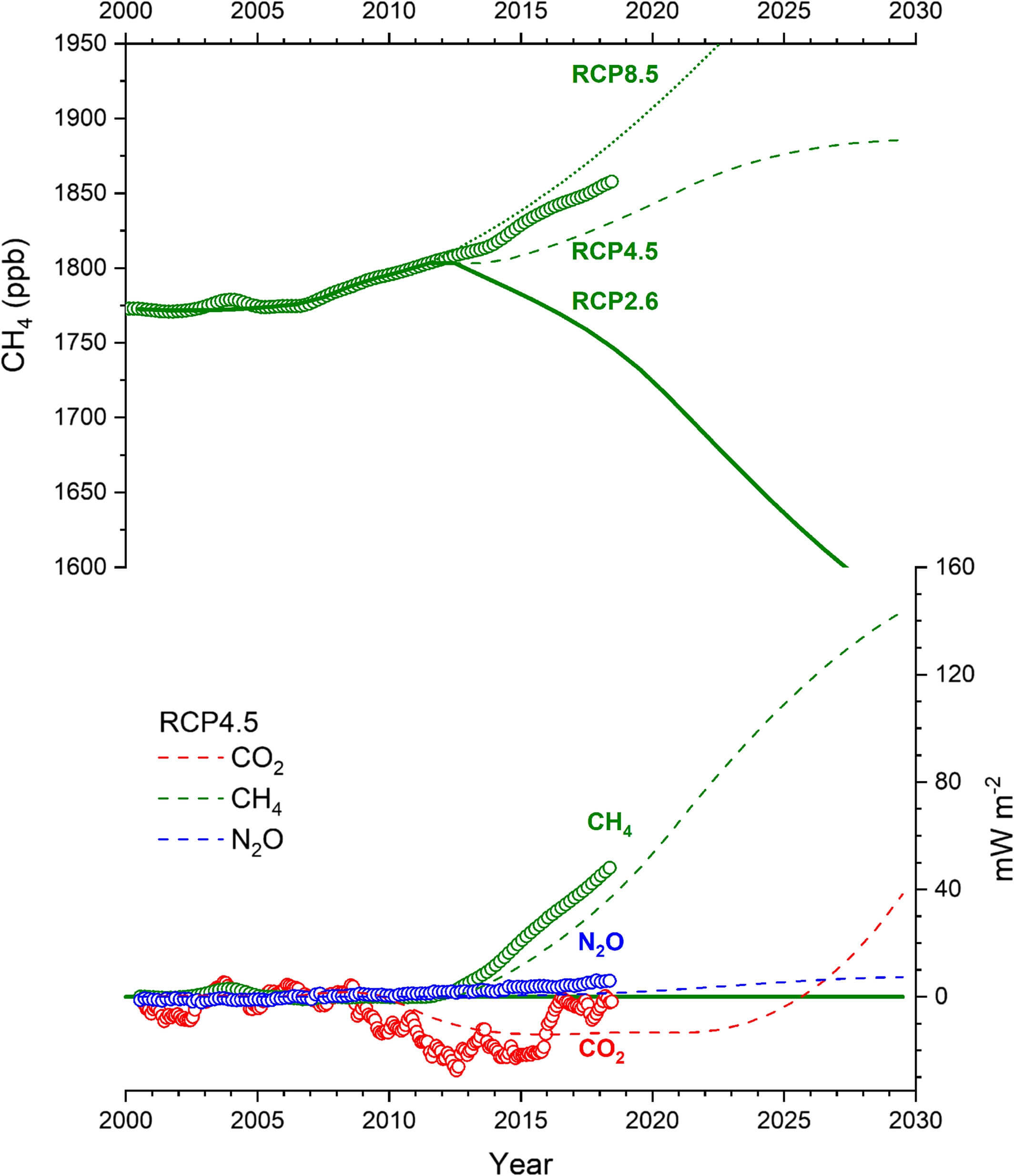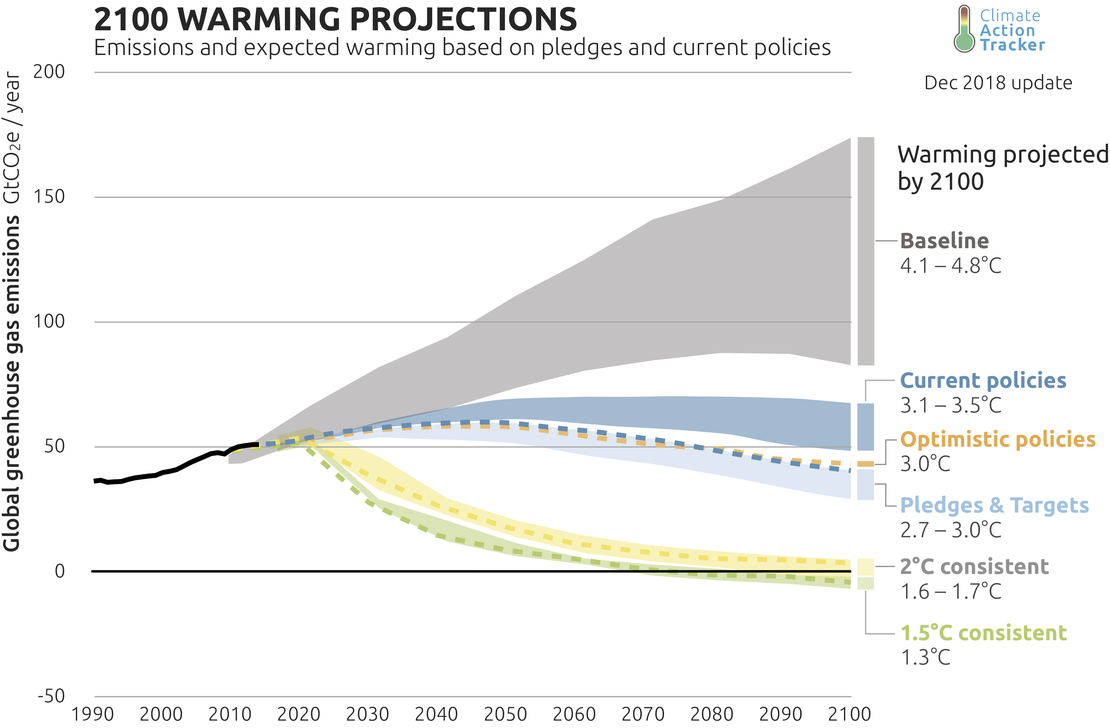Unexpected methane rising
Vegan Society of Canada News
June 27th 2019
As we have previously discussed we do not have an adequate safety margin in our current climate change targets. When we are discussing about the future of life on earth it may be wise to build in some wide safety margin just in case we made some errors. There are many places where errors could creep in, from population growth estimate to the impact of methane. This in-depth research published by the American Geophysical Union (AGU) looks at our problems with methane estimates. First, as we previously discussed our formula for calculating the impact of methane into CO2 equivalent could be wrong and too optimistic. This has been discussed before and is one of the reasons why animal agriculture’s impact on climate varies between 14% and 51% of all emissions, with the reality most likely being somewhere in between. However, we will not be discussing this here but a more simple form of error: Levels are increasing much more than we predicted. So much so that the paper state:
There remain major uncertainties about the emissions contributed by fossil fuel, agricultural and natural sources, and the proportions they constitute in the total budget. Unless the reasons for the current rise are understood, and it is determined whether or not growth is due to climate change feedbacks, it will not be possible to predict future trends in methane, nor to manage future feedbacks that may be driving the increase
the renewed strong methane growth that began in 2007 was so unexpected that it was not considered in pathway models preparatory to the Paris Agreement
The increase is much more in line with a Representative Concentration Pathway (RCP) 8.5 than 1.9.
For reference RCP1.9, RCP2.6, RCP4.5, and RCP8.5 are consistent with scenario keeping temperature below 1.7°C, 2.6°C, 3.1°C and 4.8°C respectively with 95% confidence. The paper goes on to explore 3 probable causes to this unexpected increase
- Microbial emission from livestock, agriculture and/or wetland
- Fossil fuel emission
- The oxidative capacity, or cleansing power, of the atmosphere is declining
The paper does not make some definitive conclusion as to which one is the primary cause but suggest it maybe mainly a combination of microbial and fossil fuel emission. On the subject of animal agriculture the paper state:
Ruminant emissions, especially cows, may also have played a major role. Ruminant emissions are isotopically almost indistinguishable from wetland emissions. A cow is a walking wetland at 37 °C: methane from C4 (papyrus) equatorial wetlands and methane from cows fed with C4 fodder (maize, sugar cane waste) are isotopically similar and only distinguishable by back trajectory location and population analysis. Thus, it is probable that both wetlands and cows are contributing to current growth in tropical emissions.
There are large potential benefits in dietary change, especially reduction in intense factory farming of cattle, but the net cut in methane emission from taking pastureland out of food production is not easily quantified.
The stakes could not be any higher
All these gaps between our goals and where we are going are calculated without any margin of safety. It seems fair to say that the risk are skewed to the downside instead of on the upside. However, even if one believed that the risk were instead skewed to the upside, it is unequivocal that the consequence of the downside risk are exponentially more devastating than being surprised by a risk to the upside. Therefore, logic would dictate that we spend more time evaluating these unknown factors on the downside. There are many places where we could have made mistakes and just like in the case of the unexplained rise of methane we are bound to have been too optimistic in our projections. This is one of the many unknowns that could skew the risk to the downside and take us way off track, another is the existence of climate tipping points. Therefore, perhaps instead of our baseline and current policies heading somewhere in between 3.1°C-4.8°C, we may in reality be heading towards 4°C-6°C instead.
It would seem prudent that if we are discussing changes and policies that affect the future of life on earth that our plans be built with a wide margin of safety. However, the unacceptable situation we are facing is that our current policy are far from achieving our 1.5°C goal let alone have room for some margin of safety. The sad truth behind the reasons why nobody talks about building in margin of safety is that it is too late: We could not target a 1°C goal just in case we made various errors along the way because we have already reached a 1°C increase. Therefore, the only safety net we have is hope: Hope that everything we predicted was accurate or too pessimistics because we cannot afford anything else.
Of all the lever we have to influence methane emissions, arguably one of the easiest to adopt and implement with the broadest impact is changing what we eat. A change of lifestyle offers individuals a powerful means to combat a range of issues, including personal health problems, climate change, loss of biodiversity, global acidification, eutrophication, freshwater shortages, pandemic prevention, antibiotic resistance, save countless lives and much more. We know of no other efficient way for individuals to address these critical challenges simultaneously without waiting for government, corporate, or technological interventions. By changing lifestyle, people can take immediate and impactful action. We encourage you to embrace this lifestyle change today. Contact us for support and to connect with local communities in your area.






